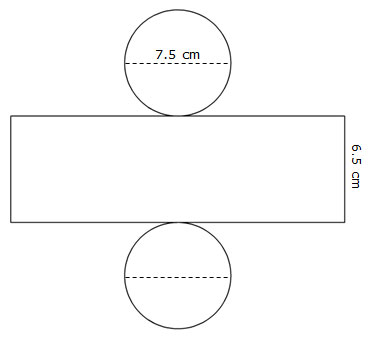In this section, you will use nets to determine the surface area of a given figure.
Let’s use the net of a cone to help us measure and describe three-dimensional figures in terms of exterior (surface area) and capacity (volume).
Based on the net of the cone that we looked at in the previous section, let’s see how the net can help derive the formula to find the surface area for the cone.
![]() The video below shows the source of the formula for the surface area of a cone and how it relates to the net of the cone.
The video below shows the source of the formula for the surface area of a cone and how it relates to the net of the cone.
Find the total surface area of the net of a cone with the height of four centimeters and a radius of three centimeters. Compare your work with the student work sample below.
Finding the surface area of a prism from its net is not as difficult as using the net of a cone.
China's National Aquatic Centre or "Water Cube" that was used in the 2008 Beijing Olympics serves as a good example. Although the building itself is a complex hexahedron, the net of a rectangular prism can be helpful in determining the surface area of the building.
![]() Click the Start Animation button below to view the animation. Once the animation is complete, you can replay it by clicking the Replay Animation button.
Click the Start Animation button below to view the animation. Once the animation is complete, you can replay it by clicking the Replay Animation button.
Given the approximate dimensions in the net of the Water Cube, what is the surface area of the exposed faces (faces that you would see if you were looking at the actual building)?
How does a net help you to determine the surface area of a three-dimensional figure?
Determine the surface area of each of the figures represented by the nets shown below.

Interactive popup. Assistance may be required.
What shapes are present in the net? What are the area formulas for those shapes?
Interactive popup. Assistance may be required.
| The figure is a triangular prism, so determine the area of the 2 congruent triangular bases and the area of the 3 rectangular lateral faces. |
|
| Area of base: A = 1 over 2 1 2 bh A = 1 over 2 1 2 (3.5 cm)(5 cm) A = 8.75 cm2 |
Area of lateral face: A = bh A = (3.5 cm)(20 cm) A = 70 cm2 |
| Total surface area = 2 × 8.75 cm2 + 3 × 70 cm2 = 227.5 cm2 | |


Interactive popup. Assistance may be required.
What shapes are present in the net? What are the area formulas for those shapes?
Interactive popup. Assistance may be required.
The figure is a cylinder, so determine the area of the two congruent circular bases and the area of the rectangular lateral surface. |
|
| Area of base: A = πr2 A = π(3.75 cm)2 A ≈ 44.16 cm2 |
Area of lateral face: A = bh A = ((7.5 cm)(π))(6.5 cm) A ≈ (23.55 cm)(6.5 cm) A ≈ 153.08 cm2 |
| Total surface area = 2 × 44.16 cm2 + 153.08 cm2 = 241.4 cm2 | |
